17 Sprint Retrospective Examples for Agile Teams
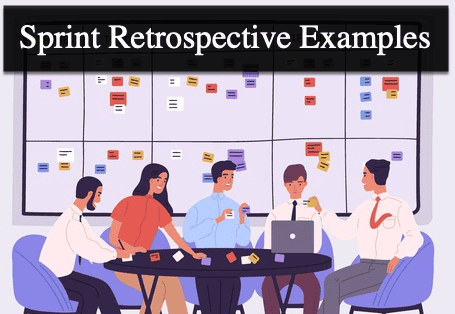
Maintaining the engagement of your agile team is essential, so experimenting with various end-of-sprint retrospective examples can add some excitement. Aim to make these sessions as enjoyable as possible. After all, we spend plenty of time being serious at work.
The idea behind retrospection is to find out what went well, what could be improved, and what could have been done better to help facilitate continuous improvement. The team will provide feedback on the progress of a project. It should be an open discussion where everyone gives their honest feedback.
There are several ways to hold an agile retrospective event. The easiest way is for every member of the team to enter their feedback on a spreadsheet, and then action items are taken if the input requires it. However, this method gets boring, which is why agile retrospective templates come in.
The best retrospective I have attended were the less severe accessible going meetings. The team felt comfortable around each other and weren’t worried about what they said. As an Agile coach, you are responsible for putting the team at ease.
Retrospectives bring a team together, celebrating what went well and reflecting on what could have gone better.
17 of our Favorite Sprint Retrospective Examples
1. Glad, Sad, Mad Sprint Retro Template
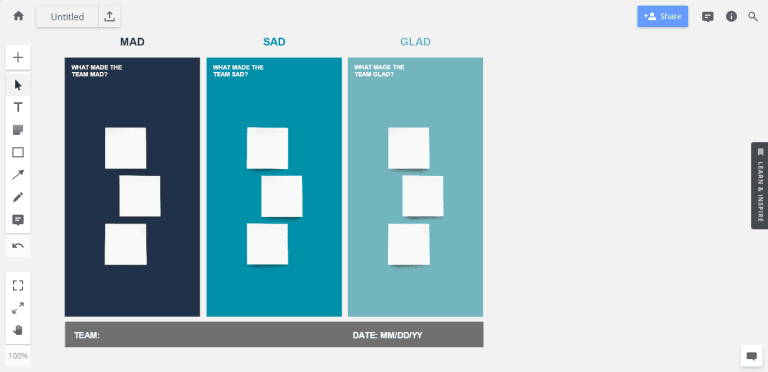
This is a template for design thinking. Instead of looking at the actual progress of the project, the template looks at the team members’ emotions. If teams feel burnt out or exhausted, the three columns can help them express their feelings and check the issues affecting them.
2. Start, Stop, Continue
This retrospective template does as its name says. It allows you to outline what needs to start, what to stop, and what should continue. There are three columns for these three sections, and members can use them to brainstorm.
3. Sailboat Retrospective Template
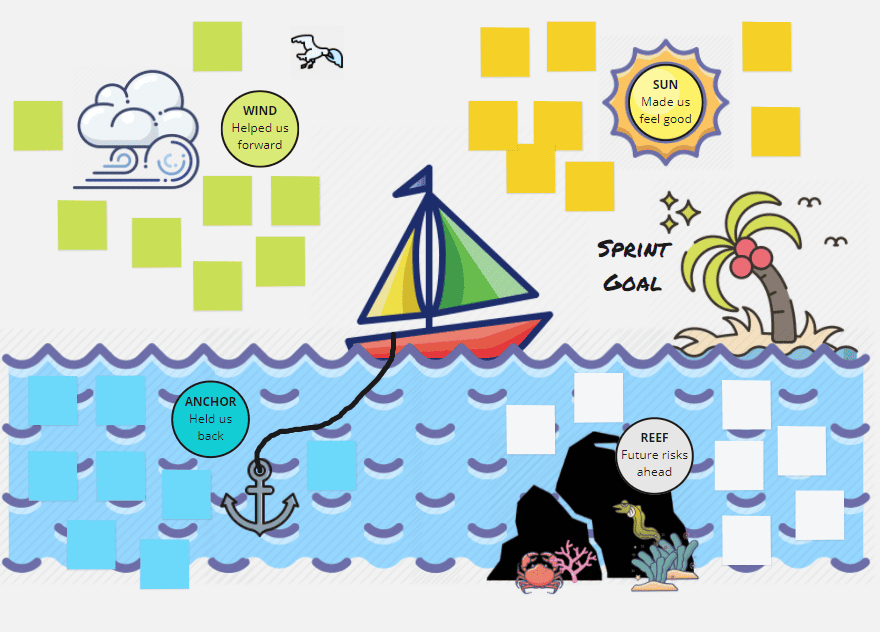
In the sailboat retrospectives the sailboat, represent teams. The sailboat is supposed to steer the teams towards the goals. It is, therefore, an excellent tool to assess the progress at every project stage. It looks at successes regarding wind (which pushes the sailboat forward) and goals for an island (where teams are supposed to go).
It considers anchors as challenges holding the team back and rocks as threats. Once teams give feedback based on that, they can forward it.
4. Starfish retrospective Template
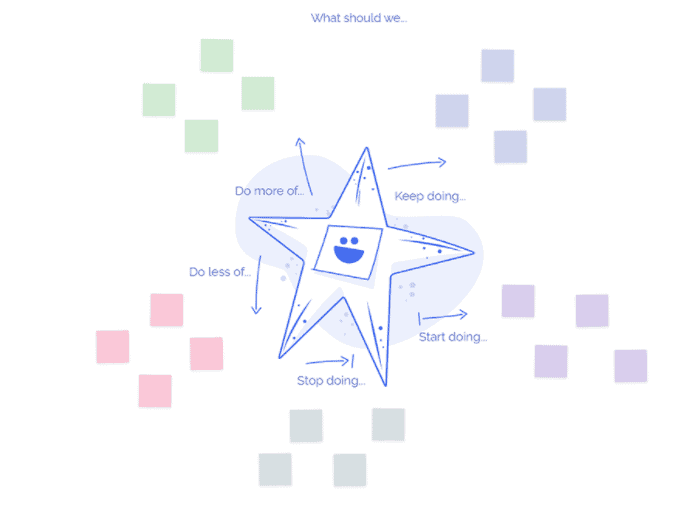
This template helps determine what team members got out of a project sprint. It is so named thanks to the five arms of the template. These include what to keep doing, what to do less, what to stop doing, what to start doing, and what to do more of.
Online Version: The Starfish Retrospective Template | Metro Retro
5. The 4 L retrospective
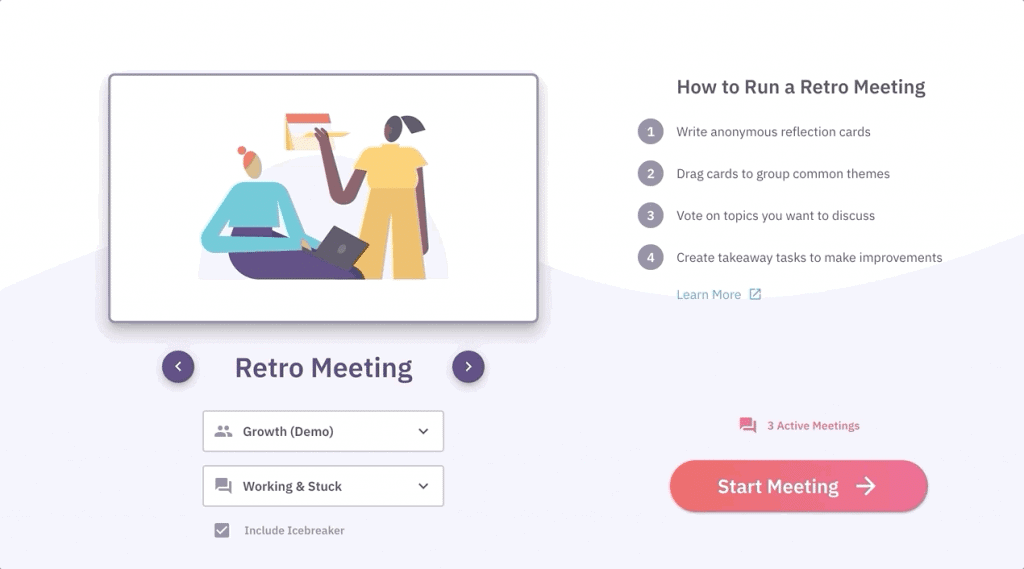
The 4L template has four quadrants where teams can enter what they liked, what they learned, what they lacked, and what they longed for. Teams can be in small groups in which they can brainstorm ideas for each of the quadrants. They can create a plan for moving forward from the ideas they enter on the quadrants.
6. Liked, Learned, Lacked
This is a template with three columns. It operates the same as the 4L retrospective template. In this case, you will have a column for what you liked, learned, and lacked. Teams can work in small groups to brainstorm ideas.
7. Feedback Grid
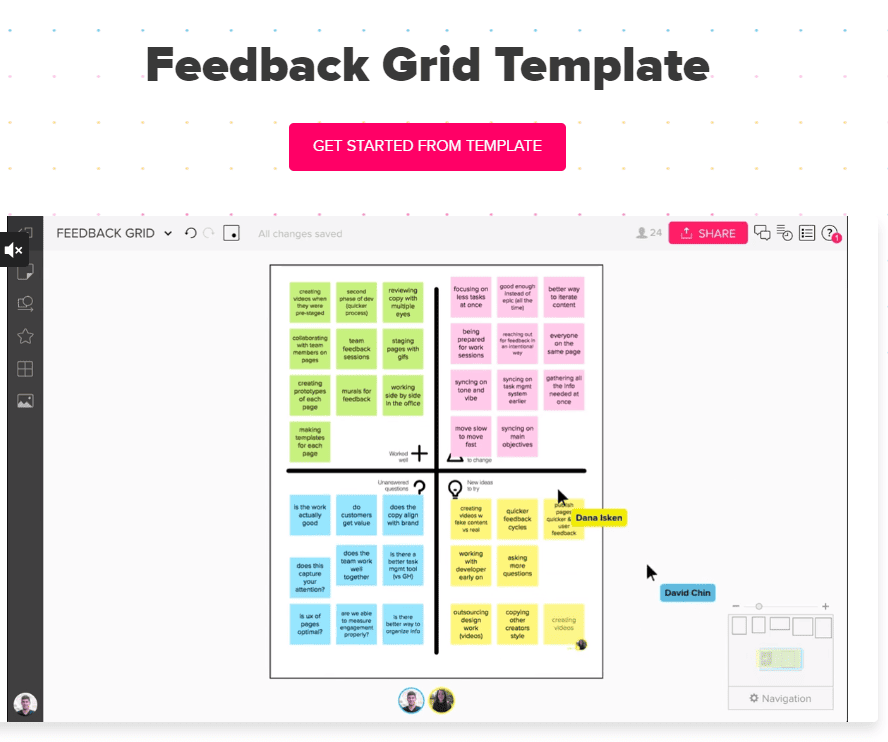
A feedback grid has four sections. It is handy when project teams need to record feedback after product testing. All positive and negative feedback must be on the grid to ensure nothing is lost by the time the project ends. The four quadrants have the following sections: Questions, Ideas, Criticisms, and Likes. Teams can fill the sections using digital sticky notes or have a physical board with sticky notes.
8. Three Little Pigs
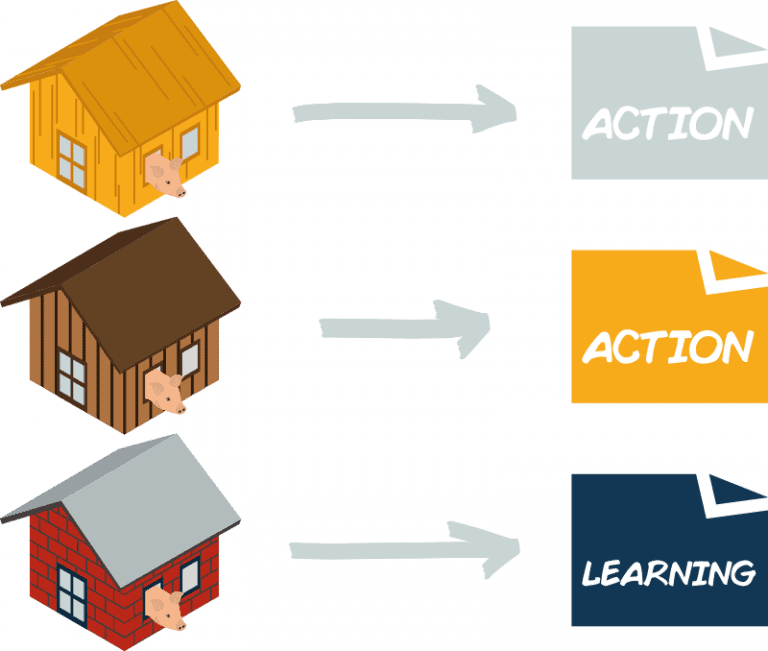
This template allows teams to identify short, medium, and long-term actions to bring the project to fruition. You can use it to analyze the current condition and project the future. The template is in three columns. House of straw for things that could fall apart any time, House of sticks for things that need improvement, and House of Bricks for things that are stable and do not need to change.
9. Rose, Thorn, Bud
The rose represents what has worked out well and needs to continue. The thorn represents challenges that you have gone through, and the bud represents the opportunities and possibilities that the team has. These three sections appear in columns where you and other team members can give their input.
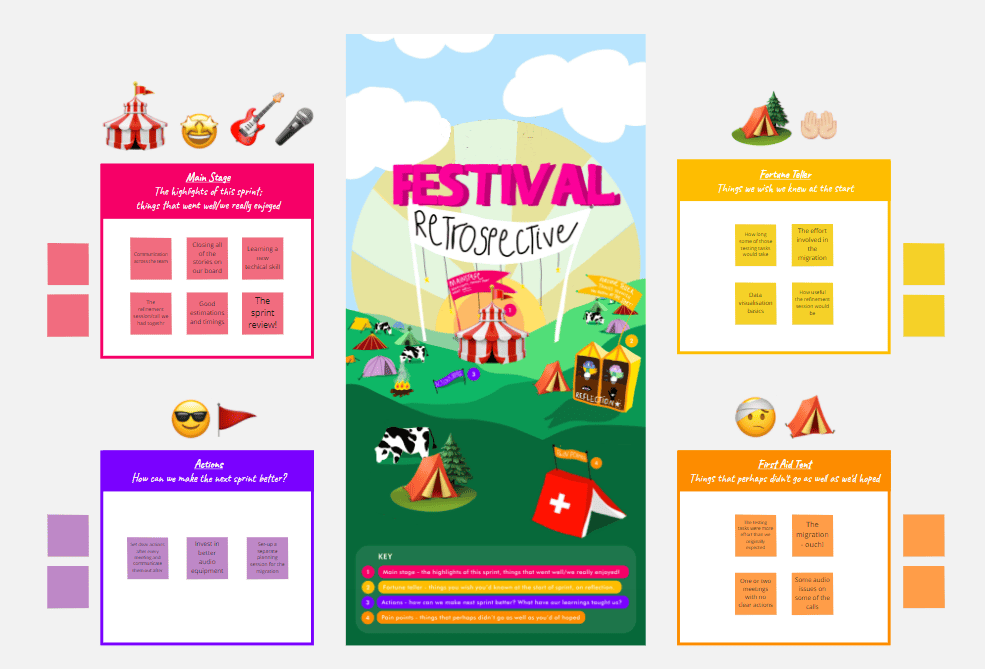
10. I like, I wish, what if?
If you are looking for a design thinking template, this will give you the platform you need. You can use it to think of the project’s next steps before you start implementation. The template can turn negative feedback into constructive criticism.
11. Working & stuck
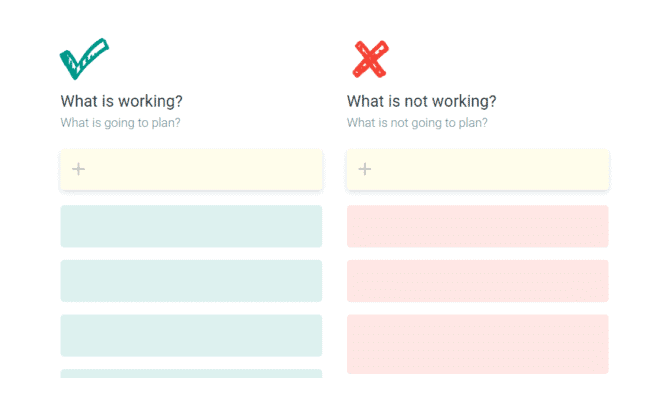
The Working & Stuck template looks at what is currently working and needs to continue and what is not working (is stuck) and needs to stop or get an improvement. There are only two columns in the template where you can fill in your ideas.
12. Quick Retrospective
If you are pressed for time and need constant updates on the project, you can use this template. It is a simple template with four sections. The first section looks at what has been good, the second what was terrible, the third takes ideas on improvement, and the fourth is for actions to be taken.
13. Anchors and Engines
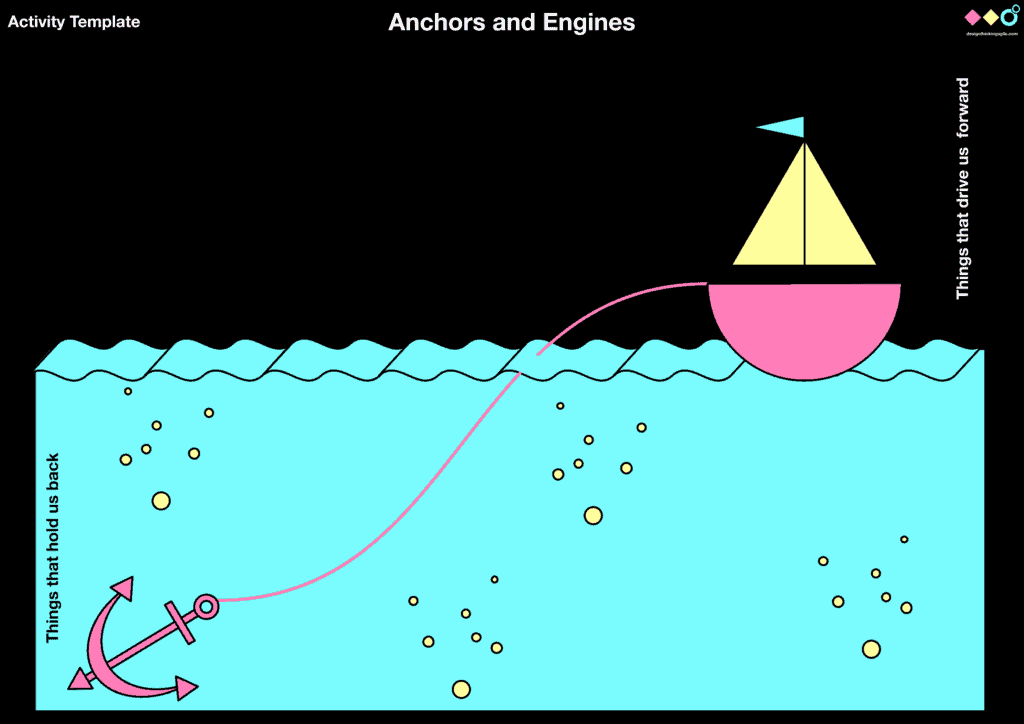
Anchors are things that are stalling the progress of a project, while engines are things that steer the project forward. Teams should work in groups to brainstorm on what goes to each column
14. Mountain Climber Retrospective
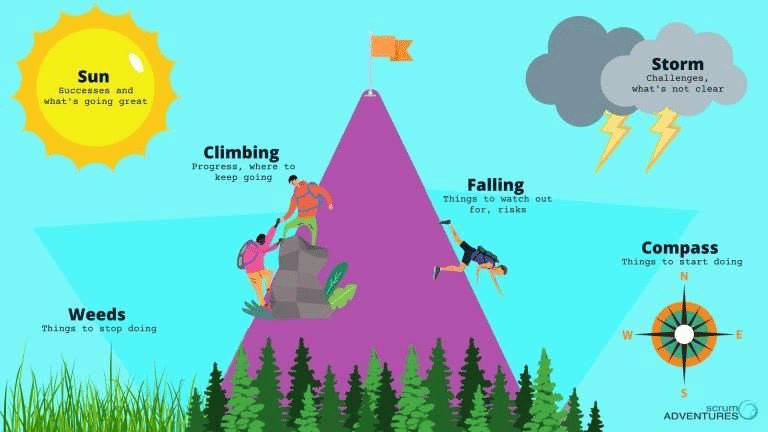
This retrospective template requires the team to imagine being at the top of a mountain. To get there, they needed ropes (things that helped them), they battled boulders (unforeseen obstacles) and the weather (challenges), and they needed first aid (solutions to problems).
15. Lessons Learned
This is an ideal retro template for teams analyzing work at the end of the project. It gives teams a platform to draw lessons from the development process. Through it, teams document failures and wins, which they can use when working on future projects. The template has four quadrants where teams list what were successful, unsuccessful, planned, and unplanned activities.
16. Trello Agile Retrospective Templates
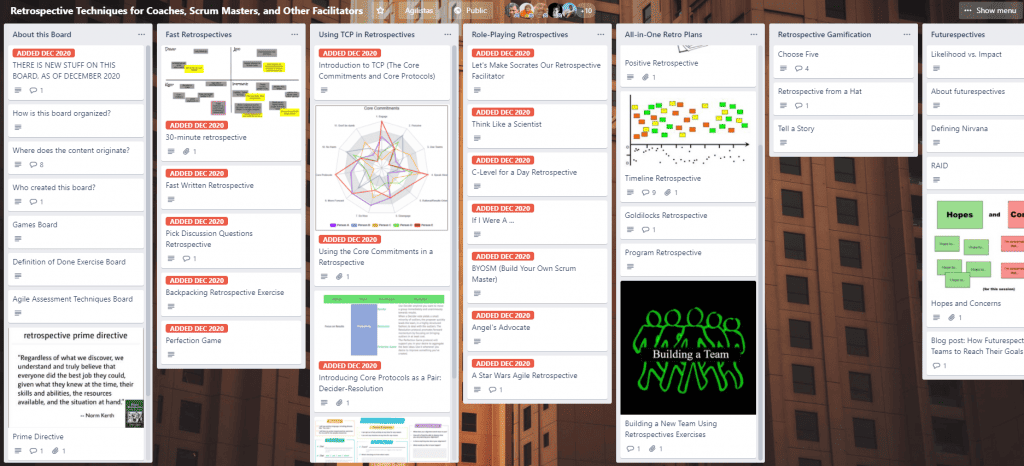
17. Hot Air Balloon Retrospective
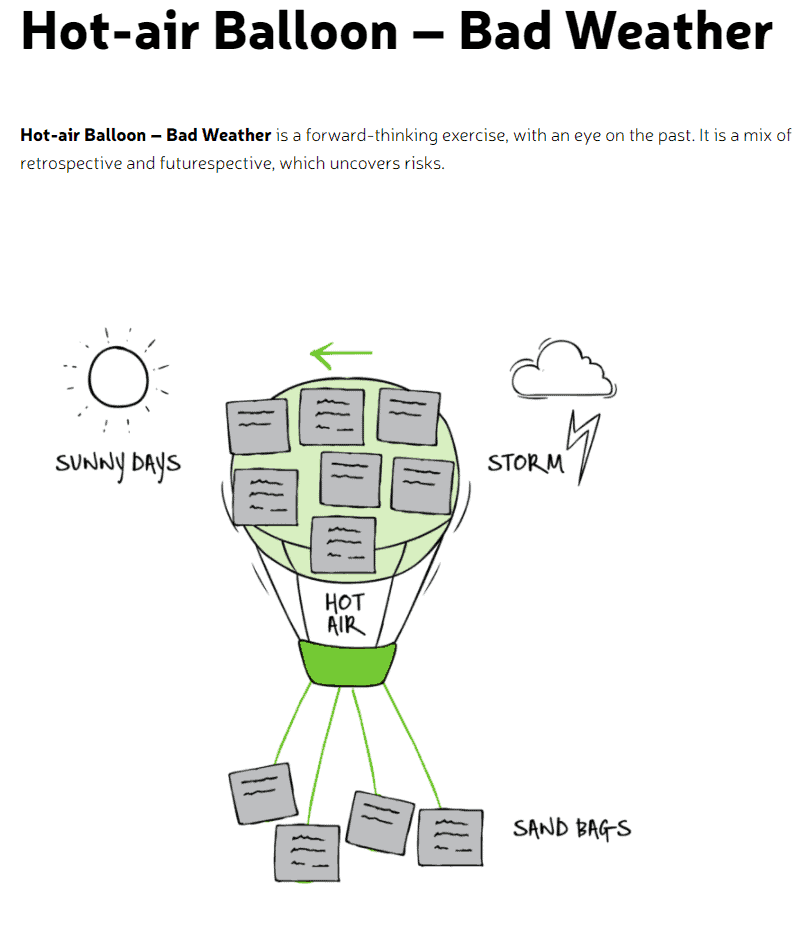
This retro template works the same as the sailboat retrospective template. With this template, teams must see themselves floating in the air and fighting elements like wind, hot air, the sun, storms, and weight. Although there is no metaphor for the goal, the template helps teams analyze challenges they may encounter.
Facilitating a Sprint Retrospective
Retrospective technique are short meetings held at end of every team sprint. These meetings are ideal for team building and also for finding loopholes in the development process. During the meeting, teams need to come together and share ideas.
The format should be as simple:
- Start with Icebreakers where they play simple games to bring members together and set the atmosphere for members to feel free to give honest feedback
- Setting the stage by introducing the retrospective topics and templates so that members can be ready with their feedback
- Combining ideas from different people on the team, giving every individual an opportunity to provide their inputs
- Voting on priorities where members see what is more important and what can wait
- Follow-up actions, such as solving problems that have come up in the process of running the project
After each release/iteration, the Scrum Master/Team Leader should hold a retrospective, also called a reflective. The retrospective aims to improve methods and teamwork by reviewing the past iteration/release. 3 core questions should be answered in every retrospective:
- What is going well
- What areas could be improved
- What should we be doing differently
Generally, a retrospective is time-boxed to 2 hours and is based on brainstorming solutions committing to a solution and discuss again, if success adds to the process. Retrospectives can be highly effective as they happen during development process providing immediate feedback on how the process is performing. If used correctly, retrospectives can result in:
- Improved productivity
- Improved capability
- Improved quality
- Improved capacity
Esther Derby and Diana Larsen defined a 5 step process for holding retrospectives.
Step 1: Set the Stage
Setting the stage is all about setting the tone of the meeting and getting the team on board. Retrospectives work best when there is a lot of engagement and genuine feedback from the team. Getting people talking early by introducing themselves and their roles is recommended, but if the team members don’t change very often, this might be seen as overkill. Next, the Scrum Master/Team Leader sets an agenda and rules for the meeting. To increase the comfort level of team members to participate in the meeting, the team can play the following games
Check-In: Round robin where people give 2 sentences on what they want to get out of retro
Focus On/Off: Get people to give their opinion on each pair of words. Conversation vs. Argument, Understanding vs. Defending
ESVP: The team anonymously identified their attitude towards retrospectives as one of the following:
- Explorers: eager to discover new ideas
- Shoppers: look for helpful info and are happy to go home with 1 idea
- Vacationers: not interested in retro but happy to be away from work
- Prisoners feel like being forced to attend
The total scores are kept and the individual votes disposed of. Then, the team is asked how they feel about the results.
Working Agreements: small groups and create agreements, create a master list.
Step 2: Gather the Data

The next step is gathering feedback from team members on what happened during iteration. The goal is to determine a shared vision of the iteration. The team leader can use the following team-based facilitation techniques to get more interaction between team members:
- Timeline: The team creates a timeline of the iteration highlighting any milestones, issues occurred during the iteration.
- Triple Nickles: 5 groups are given 5 minutes on 5 ideas 5 times
- Colour Coded Dots: Team uses sticky dots to show emotions where emotions ran high/low during the iteration.
- Mad, Sad, Glad: Team uses colored cards to describe emotional reactions during iteration
- Locate Strengths: The team discusses what went well during the iteration.
- Satisfaction Histogram: The team uses a histogram to demonstrate satisfaction for particular parts of the iteration.
- Team Radar: The team assesses performance against previous process improvement goals
- Like to Like: Team recalls experiences during iteration and compares reactions to events.
Step 3: Generate the Insights
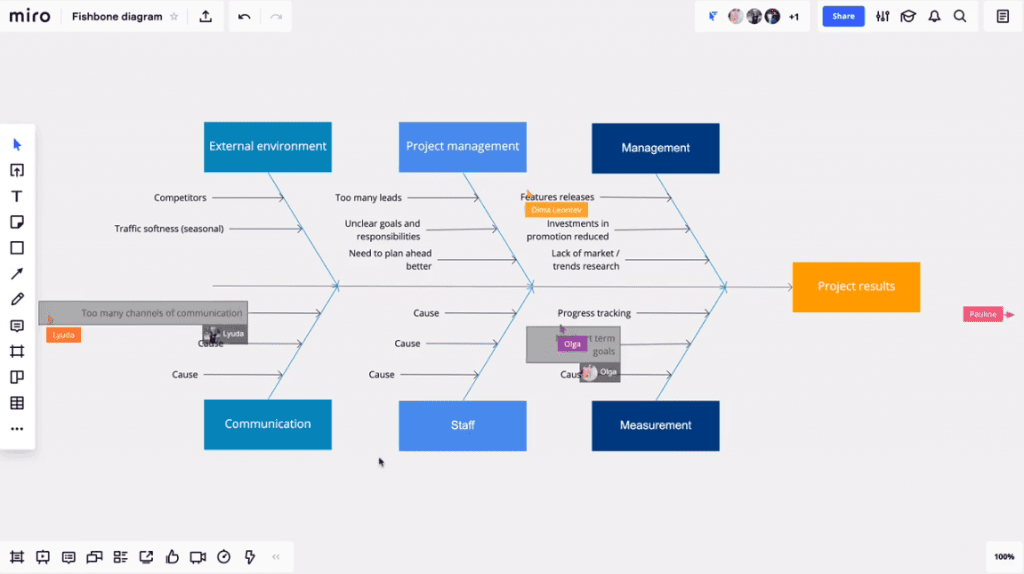
Once the data on the iteration has been gathered, it must be evaluated. The data can be assessed using the following brainstorming techniques:
- Five Why: The team works in pairs where they look at an issue and try find a solution by asking “Why?” numerous times to any reason for the issue helping determine the root cause.
- Fishbone Diagram Analysis: Ishikawa diagram is a technique used to identify root cause demonstrated in the diagram to the left. The team draws out the diagram, each branch is one area and then within that branch are possible reasons for that branch. The diagram should have all potential causes and the area of the issue.
- Prioritise with Dots: Team uses dots to vote on what they feel is important to them.
- Identify Themes: The team identifies recurring patterns in the data gathered.
Step 4: Decide What To Do
After the data has been evaluated and the team have the insights into the issues they must decide how to rectify them. The “circle of questions” technique can be used to give individuals opportunities to provide solutions where a person picks an issue and the next person proposes a solution.
Any goals created to rectify an issue must be SMART goals (Specific, Measurable, Attainable, Relevant & Timely). This will help ensure the goals are achievable within the next iteration and can be reviewed after. To sort the issues the team can use an action wheel where each item is categorised simply by choosing Keep/Drop/Add or Start/More/Less.
Step 5: Close the Sprint Retrospective
The final stage of the retrospective is formally closing it. The 4 tasks identified to close the retrospective is:
- Plus/Delta: What they want to do more of and want to change
- Helped, Hindered, Hypothesis: Feedback on the retrospective allows everyone to give feedback.
- Return on invested Time: Team grade meeting 1-5
- Appreciations: The team members express gratitude to each other.
Esther Derby & Diana Larsen Going Through 5 Stages
>> For more information check out this PDF extract of Esther & Dianna book
Mistakes to Avoid for End of Sprint Retrospectives
There are many retrospective ideas for remote teams and agile retrospective tools free online for teams. Teams can choose retrospective tools online, or they can use physical boards; whatever they find easy to use and enjoy. Teams need to avoid:
• Groupthink and instead offer honest individual ideas
• Being technology-dependent at all times
• Arguing amongst each other, but instead perform deep analysis of everyone’s ideas
• Avoid negativity and instead focus on the goals
Instead of the entire team airing their ideas, individuals or small groups within the team need to sit and brainstorm. This way, the ideas will be more honest and teams can forge forward with ease.
Why are Agile Retrospective Templates Important?
It is essential for all agile teams, including a remote team. It provides the time teams need to reflect and analyze the progress of a project. A team will also find ways to do things better. Besides finding pitfalls, teams can celebrate the success and progress they have had so far.
Other benefits that agile retrospective offers include:
- Improved communication between the team members
- Time to address any issues between the members and curb problems before they exacerbate
- Inform all members of any challenges and remind them of the project goals
- Empower agile teams to solve problems on their own
- Plan on future actions as a team
- Offer an opportunity for team building and to energize the teams
Agile retrospective templates are ideal as they offer a simple framework for teams to collect feedback. Unlike a spreadsheet with no fun structure, templates are simple and easy to use and remember for teams.
Software development teams (scrum teams) will benefit from retrospective templates more. However, the templates work perfectly for different projects. You can do agile retrospection after every sprint or at the end of a development project. If you have short (a few weeks) projects, you can have a review after completing the project. However, if your project runs for a few months, you might need to hold a retrospective event after a sprint.
FAQ – Agile end of Sprint Retrospective
What Agile teams often get wrong with the retrospective?
An excellent agile retrospective should be kept process light so it is simple to follow and let the conversation flow. What teams get wrong though is not time boxing responses by individuals so everyone in the team gets an opportunity to speak.
What is a Good Sprint Retrospective Template?
A retrospective template has three to four sections or quadrants where teams enter information. Generally, every retro can be tied back to these 3 questions: What activities went well? What activities didn’t go as well? What should we continue?
Why do I need a retrospective template?
Having a retrospective templates enables the team to have the retrospective quicker to setup and gets straight to the teams feedback. Having the team not worry about the format is a sign of a great template.
How to choose a retrospective template
Members who have had agile retrospective meetings should refer to the previous retrospective templates to see if problems recur. Templates should be stored for review in the next retrospective.



